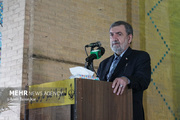Alireza Qorbanzadeh said that the renovation and installation of tile works will continue in winter in order to accelerate the process.
Soltanieh is the world’s third tallest religious monument after the Saint Mary Church in the Italian city of Florence and the Aya Sofia Mosque in Istanbul.
The monument was registered on the UNESCO World Heritage List on July 15, 2005 during the 29th Session of the World Heritage Committee, which was held in Durban, South Africa.
“Almost 90,000 tiles are needed for the renovation, which will take three years to complete,” Qorbanzadeh added.
Soltanieh, the mausoleum of Oljaitu, was constructed from 1302 to 1312 in the city of Soltanieh, the capital of the Ilkhanids, Mongol descendents of Genghis Khan who controlled large parts of Iran from 1256 to 1349.
The octagonal building is crowned with a dome 50 meters in height covered in turquoise blue faience and surrounded by eight slender minarets.
In an interview with the Cultural Heritage News agency in July, Saeid Kashani, an expert of the Soltanieh Dome restoration team, said, “Ilkhanid kings used to demonstrate their kingdom’s power and splendor through the construction of buildings with beautiful decorative architecture. Soltanieh has various kinds of tile work, including mosaic faience and luster tiles, which are characterized by varied structure and characteristics.
“The tile works are mainly in turquoise and azure, which were more commonly used than other colors during the Ilkhanid era. In addition, the tile works of the monument are in characteristic aubergine and white. Although no precise formula had been invented for white color at that time, the white that was used in the tile works is very stable and beautiful.”
The monument was constructed during the reign of Sultan Mohammad Khodabandeh (Oljaitu) with the aim of making it the new tomb of Imam Ali (AS), but he was unable to realize his goal.
RM/HG
END
MNA



















Your Comment